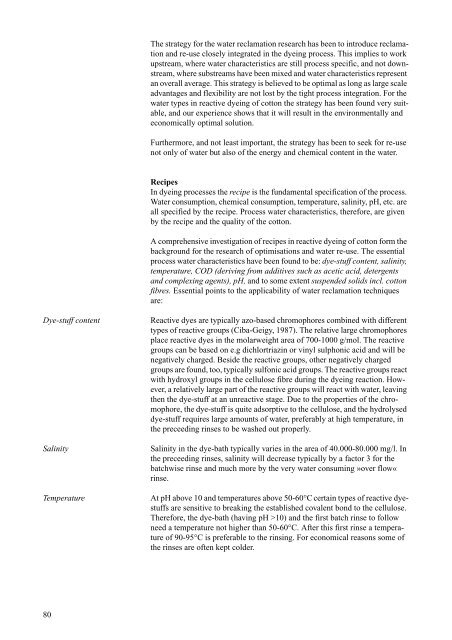Cleaner Technology Transfer to the Polish Textile ... - Miljøstyrelsen
Cleaner Technology Transfer to the Polish Textile ... - Miljøstyrelsen
Cleaner Technology Transfer to the Polish Textile ... - Miljøstyrelsen
You also want an ePaper? Increase the reach of your titles
YUMPU automatically turns print PDFs into web optimized ePapers that Google loves.
80<br />
The strategy for <strong>the</strong> water reclamation research has been <strong>to</strong> introduce reclamation<br />
and re-use closely integrated in <strong>the</strong> dyeing process. This implies <strong>to</strong> work<br />
upstream, where water characteristics are still process specific, and not downstream,<br />
where substreams have been mixed and water characteristics represent<br />
an overall average. This strategy is believed <strong>to</strong> be optimal as long as large scale<br />
advantages and flexibility are not lost by <strong>the</strong> tight process integration. For <strong>the</strong><br />
water types in reactive dyeing of cot<strong>to</strong>n <strong>the</strong> strategy has been found very suitable,<br />
and our experience shows that it will result in <strong>the</strong> environmentally and<br />
economically optimal solution.<br />
Fur<strong>the</strong>rmore, and not least important, <strong>the</strong> strategy has been <strong>to</strong> seek for re-use<br />
not only of water but also of <strong>the</strong> energy and chemical content in <strong>the</strong> water.<br />
Recipes<br />
In dyeing processes <strong>the</strong> recipe is <strong>the</strong> fundamental specification of <strong>the</strong> process.<br />
Water consumption, chemical consumption, temperature, salinity, pH, etc. are<br />
all specified by <strong>the</strong> recipe. Process water characteristics, <strong>the</strong>refore, are given<br />
by <strong>the</strong> recipe and <strong>the</strong> quality of <strong>the</strong> cot<strong>to</strong>n.<br />
A comprehensive investigation of recipes in reactive dyeing of cot<strong>to</strong>n form <strong>the</strong><br />
background for <strong>the</strong> research of optimisations and water re-use. The essential<br />
process water characteristics have been found <strong>to</strong> be: dye-stuff content, salinity,<br />
temperature, COD (deriving from additives such as acetic acid, detergents<br />
and complexing agents), pH, and <strong>to</strong> some extent suspended solids incl. cot<strong>to</strong>n<br />
fibres. Essential points <strong>to</strong> <strong>the</strong> applicability of water reclamation techniques<br />
are:<br />
Dye-stuff content Reactive dyes are typically azo-based chromophores combined with different<br />
types of reactive groups (Ciba-Geigy, 1987). The relative large chromophores<br />
place reactive dyes in <strong>the</strong> molarweight area of 700-1000 g/mol. The reactive<br />
groups can be based on e.g dichlortriazin or vinyl sulphonic acid and will be<br />
negatively charged. Beside <strong>the</strong> reactive groups, o<strong>the</strong>r negatively charged<br />
groups are found, <strong>to</strong>o, typically sulfonic acid groups. The reactive groups react<br />
with hydroxyl groups in <strong>the</strong> cellulose fibre during <strong>the</strong> dyeing reaction. However,<br />
a relatively large part of <strong>the</strong> reactive groups will react with water, leaving<br />
<strong>the</strong>n <strong>the</strong> dye-stuff at an unreactive stage. Due <strong>to</strong> <strong>the</strong> properties of <strong>the</strong> chromophore,<br />
<strong>the</strong> dye-stuff is quite adsorptive <strong>to</strong> <strong>the</strong> cellulose, and <strong>the</strong> hydrolysed<br />
dye-stuff requires large amounts of water, preferably at high temperature, in<br />
<strong>the</strong> preceeding rinses <strong>to</strong> be washed out properly.<br />
Salinity Salinity in <strong>the</strong> dye-bath typically varies in <strong>the</strong> area of 40.000-80.000 mg/l. In<br />
<strong>the</strong> preceeding rinses, salinity will decrease typically by a fac<strong>to</strong>r 3 for <strong>the</strong><br />
batchwise rinse and much more by <strong>the</strong> very water consuming »over flow«<br />
rinse.<br />
Temperature At pH above 10 and temperatures above 50-60°C certain types of reactive dyestuffs<br />
are sensitive <strong>to</strong> breaking <strong>the</strong> established covalent bond <strong>to</strong> <strong>the</strong> cellulose.<br />
Therefore, <strong>the</strong> dye-bath (having pH >10) and <strong>the</strong> first batch rinse <strong>to</strong> follow<br />
need a temperature not higher than 50-60°C. After this first rinse a temperature<br />
of 90-95°C is preferable <strong>to</strong> <strong>the</strong> rinsing. For economical reasons some of<br />
<strong>the</strong> rinses are often kept colder.

















